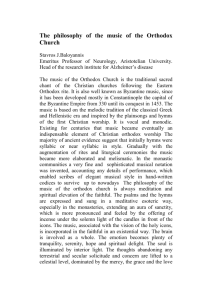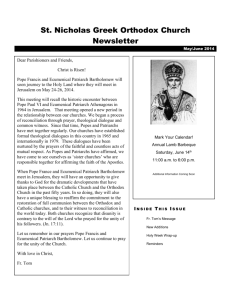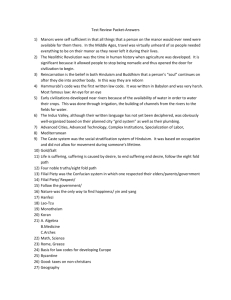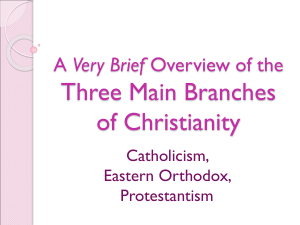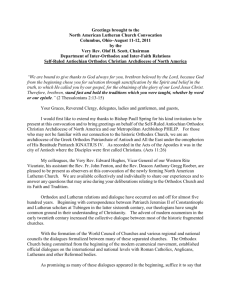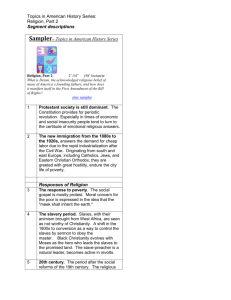orthodoxy and heresy of the anti
advertisement
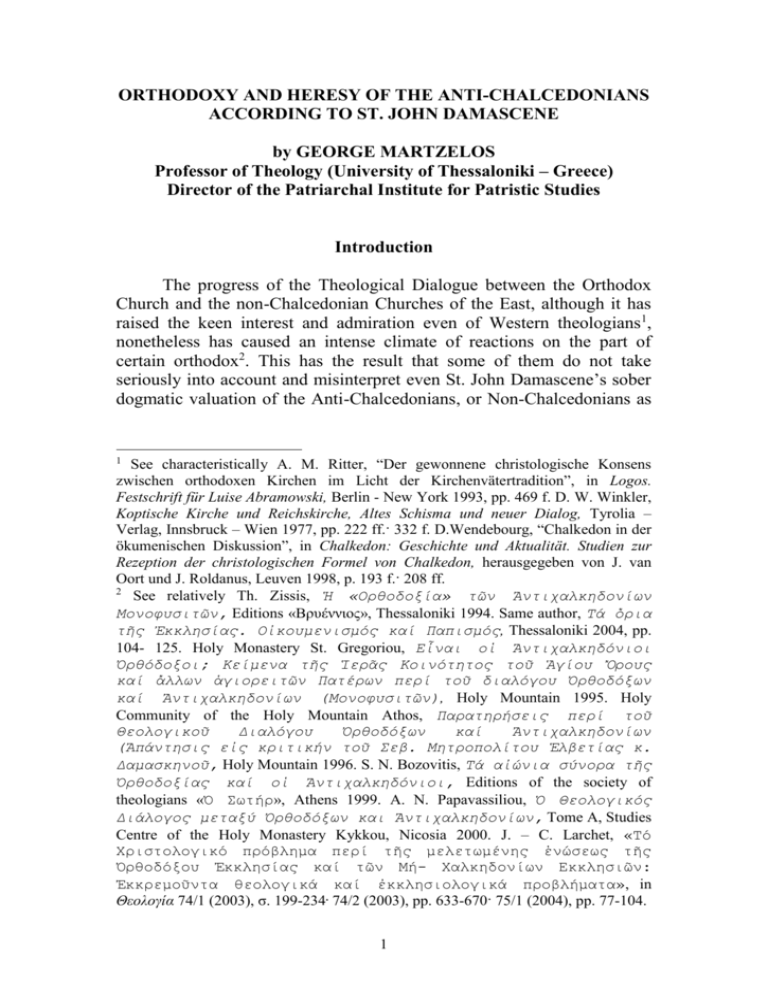
ORTHODOXY AND HERESY OF THE ANTI-CHALCEDONIANS ACCORDING TO ST. JOHN DAMASCENE by GEORGE MARTZELOS Professor of Theology (University of Thessaloniki – Greece) Director of the Patriarchal Institute for Patristic Studies Introduction The progress of the Theological Dialogue between the Orthodox Church and the non-Chalcedonian Churches of the East, although it has raised the keen interest and admiration even of Western theologians1, nonetheless has caused an intense climate of reactions on the part of certain orthodox2. This has the result that some of them do not take seriously into account and misinterpret even St. John Damascene’s sober dogmatic valuation of the Anti-Chalcedonians, or Non-Chalcedonians as See characteristically A. M. Ritter, “Der gewonnene christologische Konsens zwischen orthodoxen Kirchen im Licht der Kirchenvätertradition”, in Logos. Festschrift für Luise Abramowski, Berlin - New York 1993, pp. 469 f. D. W. Winkler, Koptische Kirche und Reichskirche, Altes Schisma und neuer Dialog, Tyrolia – Verlag, Innsbruck – Wien 1977, pp. 222 ff.· 332 f. D.Wendebourg, “Chalkedon in der ökumenischen Diskussion”, in Chalkedon: Geschichte und Aktualität. Studien zur Rezeption der christologischen Formel von Chalkedon, herausgegeben von J. van Oort und J. Roldanus, Leuven 1998, p. 193 f.· 208 ff. 2 See relatively Th. Zissis, Ἡ «Ορθοδοξία» τῶν Ἀντιχαλκηδονίων Μονοφυσιτῶν, Εditions «Βρυέννιος», Thessaloniki 1994. Same author, Τά ὅρια τῆς Ἐκκλησίας. Οἰκουμενισμός καί Παπισμός, Thessaloniki 2004, pp. 104- 125. Holy Monastery St. Gregoriou, Εἶναι οἱ Ἀντιχαλκηδόνιοι Ὀρθόδοξοι; Κείμενα τῆς Ἱερᾶς Κοινότητος τοῦ Ἁγίου Ὄρους καί ἄλλων ἁγιορειτῶν Πατέρων περί τοῦ διαλόγου Ὀρθοδόξων καί Ἀντιχαλκηδονίων (Μονοφυσιτῶν), Holy Mountain 1995. Holy Community of the Holy Mountain Athos, Παρατηρήσεις περί τοῦ Θεολογικοῦ Διαλόγου Ὀρθοδόξων καί Ἀντιχαλκηδονίων (Ἀπάντησις εἰς κριτικήν τοῦ Σεβ. Μητροπολίτου Ἑλβετίας κ. Δαμασκηνοῦ, Holy Mountain 1996. S. N. Bozovitis, Τά αἰώνια σύνορα τῆς Ὀρθοδοξίας καί οἱ Ἀντιχαλκηδόνιοι, Editions of the society of theologians «Ὁ Σωτήρ», Athens 1999. A. N. Papavassiliou, Ὁ Θεολογικός Διάλογος μεταξύ Ὀρθοδόξων και Ἀντιχαλκηδονίων, Tome A, Studies Centre of the Holy Monastery Kykkou, Nicosia 2000. J. – C. Larchet, «Τό Χριστολογικό πρόβλημα περί τῆς μελετωμένης ἑνώσεως τῆς Ὀρθοδόξου Ἐκκλησίας καί τῶν Μή- Χαλκηδονίων Εκκλησιῶν: Ἐκκρεμοῦντα θεολογικά καί ἐκκλησιολογικά προβλήματα», in Θεολογία 74/1 (2003), σ. 199-234. 74/2 (2003), pp. 633-670· 75/1 (2004), pp. 77-104. 1 1 they are called nowadays, which is made in his work De haeresibus3. Actually in this work, the great and precise dogmatologist of the Orthodox Church, aiming at examining the different heresies and making them known, does not fail to mention among others also the AntiChalcedonians, describing in a clear and indisputable way their dogmatic identity. Although he detects their heretical character, which is constituted in their secession from the Orthodox Church due to their refusal to accept the Definition of Chalcedon and more generally the decisions of the Fourth Ecumenical Council, he does not hesitate to recognize their orthodoxy in all other matters pointing out the following: “Egyptians or Schematics (in other manuscripts Schismatics) and Monophysites; are those who on the pretence of the Chalcedonian dogma seceded from the Orthodox Church. They are also called Egyptians, because the Egyptians first started this schema (in other manuscripts schism) at the times of the emperors Marcian and Valentinian, and they are orthodox in everything else. These, sympathizing Dioscorus of Alexandria who had been condemned in the council of Chalcedon as a counsel of Eutyches’ teaching, became averse to the council and as far as it was up to them they caused thousands of accusations against it… proving that they are perverse and empty-minded” («Αἰγύπτιοι, οἱ καὶ Σχηματικοί [in other manuscripts Σχισματικοί], καὶ Μονοφυσῖται· οἱ προφάσει τοῦ ἐν Χαλκηδόνι συντάγματος τοῦ τόπου ἀποσχίσαντες τῆς Ὀρθοδόξου Ἐκκλησίας. Αἰγυπτιακοὶ δὲ προσείρηνται, διὰ τὸ πρώτους Αἰγυπτίους κατάρξασθαι τούτου τοῦ σχήματος [in other manuscripts σχίσματος] ἐπὶ Μαρκιανοῦ καὶ Οὐαλεντινιανοῦ τῶν βασιλέων· τὰ δὲ ἄλλα πάντα ὀρθόδοξοι ὑπάρχοντες. Οὗτοι δὲ προσπαθείᾳ τῇ πρὸς τὸν ἐν Ἀλεξανδρείᾳ Διόσκορον, τὸν ὑπὸ τῆς ἐν Χαλκηδόνι συνόδου καθαιρεθέντα, ὡς τὸν Εὐτυχοῦς δογμάτων συνήγορον, ἀντεπάθησαν τῇ συνόδῳ καὶ μυρίας τόγε ἐπ’ αὐτοῖς μέμψεις κατ’ αὐτῆς ἀνεπλάσαντο… σκαιοὺς αὐτοὺς καὶ 4 ματαιόφρονας ἀποδείξαντες») . Let us, though, see in detail 3 See for example Th. Zissis, Ἡ «Ορθοδοξία» τῶν Ἀντιχαλκηδονίων Μονοφυσιτῶν, Εditions «Βρυέννιος», Thessaloniki 1994, pp. 18 ff. Same author, Τά ὅρια τῆς Ἐκκλησίας. Οἰκουμενισμός καί Παπισμός, Thessaloniki 2004, pp. 115 ff. Holy Community of the Holy Mountain Athos, loc. cit., p. 71. J. – C. Larchet, loc. cit., in Θεολογία 74/2 (2003), pp. 661 ff. See also D. Tselegides, «Ἐπιστημονική κριτική μιᾶς διδακτορικῆς διατριβῆς», in Γρηγόριος ὁ Παλαμᾶς 85/792 (2002), pp. 311 f. 4 See PG 94, 741 A. 2 which is the dogmatic identity of the Anti-Chalcedonians, on the basis of St. John Damascene’s description and evaluation of this heresy. a) The dogmatic identity of the Anti-Chalcedonians Certain orthodox theologians are of the opinion that the dogmatic identity of the Anti-Chalcedonians according to St. John Damascene consists in their Monophysite Christology. They hold that this is already manifested by their characterization by Damascene as “Monophysites” in the above passage from his work De haeresibus5. We should stress from the beginning, though, that the opinion of these theologians is completely erroneous because the characterization “Monophysites” is not used in the above passage to state the dogmatic identity of Dioscorus and his followers; it is simply one of the various names which were given to them by their orthodox rivals and by which they were known in Damascene’s times. As the characterizations “Egyptians” and “Schematics” were attributed to them according to Damascene “because the Egyptians first started this schema (schism) at the times of the emperors Marcian and Valentinian”6, in the same way the characterization “Monophysites” was attributed to them by the orthodox because they had apparently turned down the Chalcedonian Definition and had exclusively accepted only the Cyrillian formula “One nature of God the Word incarnate” («Μία φύσις τοῦ Θεοῦ Λόγου σεσαρκωμένη»), and certainly not because they approved of Eutyches’ Monophysite Christology, which they also had condemned together with Eutyches himself already from the setting up of the anti-Chalcedonian schism7. Anyhow, we should take into account that Damascene in his work De haeresibus, displaying the various heresies, first mentions the names with which they were known and then goes on to the exposition of their teaching and their evaluation. Accordingly, the dogmatic identity of the anti-Chalcedonian adherents of Dioscorus in Damascene’s above sited passage, is not stated with the characterisation “Monophysites” but with that which Damascene later points out. Namely, that due to the Chalcedonian Definition they seceded 5 See Th. Zissis, Ἡ «Ορθοδοξία» τῶν Ἀντιχαλκηδονίων Μονοφυσιτῶν, Εditions «Βρυέννιος», Thessaloniki 1994, pp. 19 f. Same author, Τά ὅρια τῆς Ἐκκλησίας. Οἰκουμενισμός καί Παπισμός, Thessaloniki 2004, pp. 117. Holy Community of the Holy Mountain Athos, loc. cit., p. 71. D. Tselegides, loc. cit., p. 311. 6 See PG 94, 741 A. 7 See specifically Le Livre de Synaxaire, Patrologia Orientalis 9, pp. 372 ff., as well as the Letter of Dioscorus To Secundinus, R. Y. Ebied – L. R. Wickham, “A Collection of unpublished Letters of Timothy Aelurus”, in The Journal of Theological Studies 21 (1970), pp.337· 360. 3 from the Orthodox Church, but they remained orthodox in everything else (“on the pretence of the Chalcedonian dogma seceded from the Orthodox Church… and they are orthodox in everything else”). We should also underline the fact that Damascene is obliged to stress this point so as to differentiate Dioscorus and his followers from the anti-Chalcedonian followers of Eutyches, the so-called Eutychianists, who were real Monophysites8. Besides, the fact that Damascene characterises Dioscorus as “a counsel of Eutyches’ teaching” does not mean that he accepts a dogmatic identification between Dioscorus and Eutyches, in which case he would have included Dioscorus and his followers in the heresy of the Eutychianists and would not have differentiated them. This characterization is simply related only to Dioscorus’ deeds during the “Robber Council” (449), where with his advocacy in favour of Eutyches he had actually contributed decisively to the acquittal of the condemned by the “Standing Synod” (Ἐνδημοῦσα Σύνοδος) (448) Monophysite heresy leader. Damascene though, certainly knew that Dioscorus and his followers had specifically and categorically condemned Eutyches in retrospect. Besides, that is why apart from their secession from the Orthodox Church due to their refusal to accept the Fourth Ecumenical Council which constitutes the essence of their heresy, he regards them as orthodox in everything else, that is in their teaching. This is exactly the reason why in his work Contra Jacobitas he regards these AntiChalcedonians as agreeing with the essence of the Christological teaching of the previous Fathers of the Church, underlining those Christological elements which differentiate them from Eutyches9. See characteristically PG 94, 740 A – 744 B. See Τόμος, ὡς ἐκ προσώπου Πέτρου τοῦ ἁγιωτάτου έπισκόπου Δαμασκοῦ, Πρὸς τὸν ἐπίσκοπον δῆθεν τοῦ Δαραίας τὸν Ἰακωβίτην 14, PG 94, 1444 BCD: «Ὡμολόγηται τοίνοιν παρ᾽ ἅπασι τοῖς ἁγίοις Πατράσιν ἐκ θεότητος καὶ ἀνθρωπότητος γεγενῆσθαι τὴν ἕνωσιν, καὶ τὸν Χριστὸν ἐν θεότητι τέλειον, καὶ τέλειον καὶ ἀνελλιπῆ τὸν αὐτὸν ἐν ἀνθρωπότητι. Εἴπατε τοίνυν ἡμῖν· καὶ ὑμῖν ταῦτα δοκεῖ; Συνομολογήσετε, ὥς γέ μοι δοκεῖ… Εἰ γὰρ ἐκ θεότητος καὶ ἀνθρωπότητος τὸν Χριστὸν λέγοντες, ἐκ δύο φύσεων αὐτὸν ὁμολογεῖτε, καὶ ἴσον παρ᾽ ὑμῖν δύναται τὸ ἐκ θεότητος καὶ ἀνθρωπότητος τῷ ἐκ δύο φύσεων, πῶς θεότητα καὶ ἀνθρωπότητα τὸν Χριστὸν λέγοντες καὶ μετὰ τὴν ἕνωσιν, καὶ ἐν θεότητι καὶ ἀνθρωπότητι, οὐ δύο φύσεις αὐτὸν καὶ ἐν δυσὶν ὁμολογήσετε φύσεσι;». See relatively also A. Louth, St John Damascene. Tradition and Originality in Byzantine Theology, Oxford University Press, Oxford – New York 2002, p. 161. As is known, Eutyches denied confessing Christ “out of two natures” («ἐκ δύο φύσεων»). He said «Μὴ γένοιτο ἐμὲ εἰπεῖν ἐκ δύο φύσεων τὸν Χριστόν ἢ φυσιολογεῖν τὸν Θεόν 8 9 4 This is the correct evaluation of the dogmatic identity of the AntiChalcedonians according to St. John Damascene. Exactly the same view is also represented by two distinguished Greek dogmatologists of accredited orthodox conviction and international scientific prestige, the memorable professors John Karmiris and Rev. John Romanides. Specifically John Karmiris in his paper during the theological meeting of Orthodox and Anti-Chalcedonians in Aarhus, Denmark (1964) underlined the following: “The classical dogmatician of the Orthodox Church, John of Damascus, successfully expressed Orthodoxy’s positive attitude towards the non-Chalcedonian Christians of the East when he said that he considered them, ‘on the basis of the Constitution of Chalcedon, to be separated from the [Orthodox] Church… while being Orthodox in all other things’. Because of this situation, it is necessary that on both sides intensive efforts be made towards the reunion of the non-Chalcedonian churches with the Orthodox Church”10. In the discussion that took place after his presentation, he made the following important statement, having previously studied, as he himself stressed, not only the works of the Fathers of the Church but also those of the leaders of the Non-Chalcedonians: “I have come to the conclusion that there is no real difference between the Orthodox and the nonChalcedonians as far as the essence of the Christological dogma is concerned, as all of them accept the teaching of St. Cyril of Alexandria. There is a difference only regarding the terminology and formulation of this dogma”11. Analogous is the attitude of Rev. John Romanides who, μου» (See ACO II, 1, 1, 136) He only confessed «ἐκ δύο φύσεων γεγενῆσθαι τὸν Κύριον ἡμῶν πρὸ τῆς ἑνώσεως» (See ACO II, 1, 1, 143) and union «ἐκ δύο φύσεων» (See ACO II, 1, 1, 140) so that he would have space to confess one nature after the union. For Eutyches, confessing Christ «ἐκ δύο φύσεων» meant accepting two natures after the incarnation (See on this matter G. D. Martzelos, Γένεση καί πηγές τοῦ Ὅρου τῆς Χαλκηδόνας. Συμβολή στήν ἱστορικοδογματική διερεύνηση τοῦ Ὅρου τῆς Δ΄ Οἰκουμενικῆς Συνόδου, Thessaloniki 1986, pp. 129 ff.), which constituted a basic difference against the anti- Chalcedonian followers of Dioscorus. And Damascene knew this very well during his dogmatic evaluation of the AntiChalcedonians, as it comes out of the above-cited texts. 10 See J. N. Karmiris, «The Problem of the Unification of the non-Chalcedonian Churches of the East with the Orthodox on the basis of Cyril’s formula: “Mia physis tou Theou Logou sesarkomene”», in The Greek Orthodox Theological Review 10 (1965), p. 62. See also P. Gregorios – W. H. Lazareth – N. A. Nissiotis, Does Chalcedon divide or unite? Towards Convergence in Orthodox Christology, Geneva 1981, pp. 30 f. 11 See “DISCUSSION: Concerning the paper of Professor Karmiris” in The Greek Orthodox Theological Review 10 (1965), p. 75. See also P. Gregorios – W. H. Lazareth – N. A. Nissiotis, loc. cit., p. 43. 5 regarding the anti-Chalcedonian followers of Dioscorus as orthodox concerning the essence of their Christological teaching, speaks persistently of “Chalcedonian and non-Chalcedonian Orthodox”12, making it clear that the only substantial theological difference between the “Chalcedonian and non-Chalcedonian Orthodox” is the acceptance of the Fourth Ecumenical Council. Nevertheless, it is a fact that St. John Damascene in his Expositio Accurata Fidei Orthodoxae gives the impression that he regards them as heretics also due to their Christology where he writes “not by confusion or mixture or blending as said the pursued by God Dioscorus… and Severus and their polluted faction” («… οὐ κατὰ φυρμὸν ἢ σύγχυσιν ἢ ἀνάκρασιν, ὡς ὁ θεήλατος ἔφη Διόσκορος… καὶ Σεβῆρος, καὶ ἡ τούτων ἐναγὴς συμμορία»)13. Firstly we should stress that, as has come out of the thorough and in depth study of the works of the above two anti-Chalcedonian leaders, these characterisations are not connected to their actual Christology, which is proven to have no essential difference to the Christology of Cyril of Alexandria14. They are connected to the fact that Dioscorus and Severus denied to accept the Fourth Ecumenical Council, thus becoming leaders and founders of the anti-Chalcedonian schism. According to Damascene and the other Fathers this is exactly what constitutes the essence of their heresy, not their actual Christology. Given that they had turned down the Fourth Ecumenical Council as Nestorian, in this way tearing themselves apart from the body of the Church, the Fathers were not at all concerned whether their Christology was in itself orthodox or heretical. And this is because generally for the Fathers of the Church the criterion of orthodoxy is not simply ideological but also ecclesiological. It is connected to the acceptance of the Ecumenical Councils and therefore has ecclesiological dimensions. It is characteristic for instance, that whereas Theodoret of Cyrus and Ibas of Edessa had insulted St. Cyril of Alexandria by their deeds and writings and had supported Nestorius and his teaching - for which they could have very easily been characterised as heretics -, nevertheless, because they had accepted the ecumenical See J. S. Romanides, «St. Cyril’s “One physis or hypostasis of God the Logos incarnate” and Chalcedon», in The Greek Orthodox Theological Review 10 (1965), pp. 82 f. 13 See PG 94, 993 A. 14 See on this matter the above statement of Professor J. Karmiris, as well as the two doctoral theses on this subject, E. Kesmiris, Ἡ Χριστολογία καὶ ἡ ἐκκλησιαστική πολιτική τοῦ Διοσκόρου Ἀλεξανδρείας, Thessaloniki 2000 and J. Th. Nikolopoulos, Ἡ Χριστολογία τοῦ Σεβήρου Ἀντιοχείας καί ὁ Ὅρος τῆς Χαλκηδόνας, Thessaloniki 2002. 12 6 decision of the Church and had condemned Nestorius, they were regarded as orthodox by the Fathers of the Fourth Ecumenical Council without having renounced their Nestorian-like positions. And this is why later the Fifth Ecumenical Council, which was concerned especially with their Christology, condemned their Nestorian-like and anti-Cyrillian writings, although the Fourth Ecumenical had already restored them as orthodox (condemnation of the “Three Chapters”)15. This fact indisputably shows that the criterion of orthodoxy for the Church is not only whether someone phrases a dogmatic teaching correctly or incorrectly. It is basically whether or not someone accepts the related ecumenical decision of the Church. Therefore, in this sense it was enough for the Fathers that the leaders of the Anti-Chalcedonians and their followers had turned down the Fourth Ecumenical Council, so as to reproach them as heretics. They needed nothing more to convince them about the heretical character of the Anti-Chalcedonians. Besides, it is scientifically unacceptable to interpret the various characterisations given by the Fathers of the Church to the AntiChalcedonians from a one-sided view and independently from the irrefutable historical and theological facts found in the proceedings and even in their writings. Moreover, as is known, Dioscorus of Alexandria who was the instigator of the anti-Chalcedonian schism was condemned by the Fourth Ecumenical Council not for dogmatic reasons, but only for canonical reasons. This comes out not only from the third session of the Council during which Dioscorus’ condemnation took place16, but also through what Anatolius of Constantinople stated categorically and explicitly during the fifth session of the Council, so as to preserve the phrase «ἐκ δύο φύσεων» (“out of two natures”) in the text of the initial Definition, which the imperial representatives, instigated by the papal legates, regarded as Monophysite-like connecting it to the person of Dioscorus. He stressed that “Dioscorus was not deposed because of his faith, but because he made himself excommunicated from the archbishop Leo and was called three times and did not come; that is why he was deposed” («Διὰ [τὴν] πίστιν οὐ καθῃρέθη Διόσκορος, ἀλλ’ ἐπειδὴ ἀκοινωνησίαν ἐποίησε τῷ κυρίῳ Λέοντι τῷ ἀρχιεπισκόπῳ καὶ τρίτον ἐκλήθη καὶ οὐκ ἦλθεν, διὰ τοῦτο καθῃρέθη»)17. If Dioscorus had been condemned as a heretic See V. K. Stefanidou, Ἐκκλησιαστική Ἱστορία, Athens ³1970, p. 239. Vl. Feidas, Ἐκκλησιαστική Ἱστορία A΄, Athens 1992, pp. 708 ff. 16 See ACO II, 1, 2, 8 [204] - 29 [225]. 17 See ACO II, 1, 2, 124 [320]. 15 7 for dogmatic reasons18, we understand that St. Anatolius would not have opposed such an argument against the imperial legates, because this The view that Dioscorus was condemned during the Fourth Ecumenical Council not only for canonical but also for dogmatic reasons is represented with no serious argumental basis by professor D. Tselegides. He supports this view, on the one hand on isolated “proclamations” («ἐκβοήσεις») of certain Fathers of Chalcedon who anathematised Dioscorus together with Nestorius and Eutyches, and on the other hand on the document (libellus) of Eusebius of Doryleum, who, accusing Dioscorus in Chalcedon for his misdeeds during the “Robber Council” (449), characterised him as «ὁμόδοξο… καί ὁμόφρονα τοῦ Εὐτυχοῦς… καί αἱρετικό» (See loc. cit., p. 309). This view though, apart from the above facts which prove the opposite, is completely mistaken also for the reason that the isolated proclamations of certain Fathers which were heard in the Council, as well as the characterisations of Eusebius of Doryleum against Dioscorus do not constitute a decision of the Council related to the heretical character of Dioscorus’ Christology. Besides it is clear that the isolated proclamations or accusations of certain Fathers in a local or an Ecumenical Council do not constitute a synodical decision, therefore they do not express the universality of the church conscience. For example, John of Germanicea and the papal legates, who during the fifth session of the Council had asked for a change of the initial Definition, were characterised as “Nestorians” by many of the Fathers of the Council (See ACO II, 1, 2, 123 [319] f.· 125 [321]). That though, does not mean that those Fathers, who contributed decisively with their insistence to the modification of the initial Definition and the formation of the final Definition, were regarded as heretics and Nestorians nor that they were condemned by the Fourth Ecumenical Council as such. Not by all means! Accordingly, it is scientifically impermissible to receive to the letter and take a jaundiced view of the isolated proclamations or accusations of certain Fathers in an Ecumenical Council or even more to attribute to them universal weight if there has not previously been a related decision of the Council. Only the Council expresses on this matter the universality of the Church conscience. Independently from this fact though, we should note that there is no specialist researcher in international bibliography who adopts this view that Dioscorus was condemned by the Fourth Ecumenical Council not only for canonical but also for dogmatic reasons. On the contrary, distinguished orthodox theologians and historians support exactly the opposite. Rev. G. Florovsky has emphatically stressed that the reason for which the Fathers of Chalcedon did not condemn Dioscorus for heresy was that Dioscorus did not deny the “double consubstantiality” (διπλή ὁμοουσιότητα) of God-man as Eutyches had done in the “Standing Synod” (Ἐνδημοῦσα Σύνοδος) of 448. (See G. Florovsky, The Byzantine Fathers of the Fifth Century, in the series The Collected Works of George Florovsky, vol. 8, Büchervertriebsanstalt, Vaduz 1987, p. 327). Also Rev. John Romanides, in his presentation of a special study in Aarhus Denmark 1964, supported and substantiated the view that Dioscorus was not condemned as a heretic during the Fourth Ecumenical Council because the “Robber Council” (449), at which he presided, was not regarded by the Fathers as heretical, as the restoration of Eutyches was apparently based on his confession that Christ is “of the same substance as his mother” («ὁμοούσιος τῇ μητρὶ αὐτοῦ») (See J. S. Romanides, loc.cit., pp. 97 f.). See also Vl. Feidas, Ἐκκλησιαστικὴ Ἱστορία A’, Athens 1992, p. 646, and also G. D. Martzelos, «Ἡ ἐπιστημονικότητα μιᾶς “ἐπιστημονικῆς 18 8 argument would have had no proving cogency for the orthodoxy of the phrase «ἐκ δύο φύσεων» (“out of two natures”) which Dioscorus had actually used and was included in the initial Definition19. As Rev. John Romanides supported relatively to John Karmiris’ paper in Aarhus, Denmark (1964), “…Dioscorus was considered quite Orthodox in his faith by such leading Fathers of the Council of Chalcedon, as those represented by Anatolius of Constantinople”20. Nevertheless, independently from this fact we should stress that not even one passage from Dioscorus or Severus exists where it comes out that they accept any blending or confusion of the two natures, as they are accused for by Damascene. On the contrary, there are many points where Dioscorus and Severus verbatim reject the blending, the confusion and the blurring of the two natures. Already in the Fourth Ecumenical Council Dioscorus had stated emphatically “We say neither confusion nor division nor change. Accursed be the one who says either confusion or change or mixture” («Οὔτε σύγχυσιν λέγομεν οὔτε τομὴν οὔτε τροπήν. Ἀνάθεμα τῷ λέγοντι ἤ σύγχυσιν ἤ τροπήν ἤ ἀνάκρασιν»)21. Besides, Severus time after time clearly and categorically condemns the confusing and the change of the two natures, emphatically highlighting the unconfused and the unchangeable of the two natures in Christ after the union22. Consequently, it is κριτικῆς” στή διδακτορική διατριβή τοῦ Ἠλ. Κεσμίρη, “Ἡ Χριστολογία καί ἡ ἐκκλησιαστική πολιτική τοῦ Διοσκόρου Ἀλεξανδρείας”, Θεσσαλονίκη 2000», in Γρηγόριος ὁ Παλαμᾶς 86 (798), Παντελεήμονι τῷ Β’, τῷ Παναγιωτάτῳ Μητροπολίτῃ Θεσσαλονίκης, Τεῦχος ἀφιερωτήριον ἐπί τῇ εἰς Κύριον ἐκδημίᾳ αὐτοῦ, Thessaloniki 2003, pp. 598 ff. 19 For more on this matter see G. D. Martzelos, Γένεση καί πηγές τοῦ Ὅρου τῆς Χαλκηδόνας. Συμβολή στήν ἱστορικοδογματική διερεύνηση τοῦ Ὅρου τῆς Δ΄ Οἰκουμενικῆς Συνόδου, Thessaloniki 1986, pp. 70 f., 129 f. 20 See “DISCUSSION: Concerning the paper of Professor Karmiris”, loc.cit., p. 77. See also P. Gregorios - W. Lazareth - N. A. Nissiotis, loc.cit., p. 45. 21 See ACO II, 1, 1, 112. See also what he mentions about the double consubstantiality of the incarnate Word in his “Letter to Secundinus” (R. Y. Ebied - L. R. Wickham, “A collection of unpublished Letters of Timothy Aelurus, in Journal of Theological Studies 21 [1970], p. 337, 360). 22 See indicatively the passages saved by Leontius Byzantius from Severus’ letter Πρός Σόλωνα (Κατά Μονοφυσιτῶν), PG 86, 1845 D: «Τὰ ἐξ’ ὧν ὁ Ἐμμανουὴλ ὑφεστήκει καὶ μετὰ τὴν ἕνωσιν οὐ τέτραπται, ὑφέστηκε δὲ ἐν τῇ ἑνώσει καὶ ἐν μιᾷ ὑποστάσει θεωρούμενα») and from his second oration Πρὸς Ἰωάννην τὸν Γραμματικόν (loc.cit., PG 86, 1848 A: «Καὶ τῶν ἐξ’ ὧν ἡ ἕνωσις μενόντων ἀμειώτων καὶ ἀναλλοιώτων, ἐν συνθέσει δὲ ὑφεστώτων, καὶ οὐκ ἐν μονάσιν ἰδιοσυστάτοις… Καὶ ὡς τὰ 9 scientifically unacceptable to be based one-sidedly on Damascene so as to be informed on the teaching of the Anti-Chalcedonians, as do unfortunately certain theologians and researchers23 completely erroneously and misleadingly, when we have the writings of the AntiChalcedonians, where they themselves clarify what they do and do not accept. In other words, when we examine the teaching or the views of certain writers, whether they are heretics or orthodox, it is extremely nonscientific to be solely based on others’ views and not on the source texts of the writers themselves. Such a method in no way could constitute a scientific research. So in this case also we should firstly and mainly be based on the writings of Dioscorus and Severus themselves, so as to come to any conclusions concerning their teaching. When we discover that other views exist, like those of St. John Damascene or other Fathers, which are different or opposed to our conclusions, then we are obliged to explain the reason for this differentiation. Therefore, when examining the Christology of Dioscorus or Severus from a dogmatic point of view and in the light of orthodox tradition, a researcher is obliged to answer to the following question: Why does Damascene accuse Dioscorus and Severus of accepting the blending and the confusion of the two natures in Christ when they explicitly reject any blending and confusion? –And the answer in this case is one and only: Damascene at this point is not interested in scientifically analysing the Christological teaching of Dioscorus and Severus on the basis of their statements or their writings as does the science of Theology today. For him the criterion for evaluating Dioscorus, Severus, and the rest of the Anti-Chalcedonians is the fact that they do not accept the Fourth Ecumenical Council and its Definition, where the words without confusion and unchangeably are used to describe the union of the two natures in Christ. Exactly this gives every right to Damascene to accuse them of denying the unconfused and unchangeable union of the two natures in Christ, thus accepting their blending and confusion, even though they themselves assert that they reject “confusion” and “change”. It is an accusation though, which has ἐξ’ ὧν εἷς Χριστὸς ἐν τῇ συνθέσει, τελείως καὶ ἀμειώτως ὑφέστηκεν»), also the passage from Severus which has been saved by the monk Eustathius (Ἐπιστολὴ πρὸς Τιμόθεον Σχολαστικόν, περὶ δύο φύσεων κατὰ Σεβήρου, PG 86, 912 CD: «Τὸ γὰρ ἐκ δύο τινῶν συνενηνεγμένον, οὔτε τὰ ἐξ’ ὧν συνετέθη συνέχεεν… Τῶν μὲν ἐξ’ ὧν ἐστιν ὁ Χριστὸς μενόντων ἀμειώτων καὶ ἀναλλοιώτων, ἐν συνθέσει δὲ ὑφεστώτων»). Analytically on this matter see J. Th. Nikolopoulos, Ἡ Χριστολογία τοῦ Σεβήρου Ἀντιοχείας καί ὁ Ὅρος τῆς Χαλκηδόνας (Doctoral Thesis), Thessaloniki 2002, pp. 89 ff.· 93 ff.· 249 ff. 23 See for example D. Tselegides, loc. cit., p. 311 and J.-C. Larchet, loc. cit., in Θεολογία 74/2 (2003), pp.663 f. 10 come out of this particular way of understanding the facts on the basis of the above reasoning, and not on the basis of any research which Damascene might have conducted on the source texts of either Dioscorus or Severus or the rest of the Anti-Chalcedonians. Anyhow, he was not interested in any research of this kind, because his purpose in this case was polemical and pastoral. He wanted to protect the orthodox flock from the danger of the ones who repudiated the Fourth Ecumenical Council. He was not interested in this case whether their Christology was in itself heretical or orthodox. For him as the Anti-Chalcedonians had not accepted the Church’s ecumenical decision during the Fourth Ecumenical Council, they were heretics. Moreover, we should always keep in mind that the Fathers were pastors and as such were interested not so much in exact scientific analyses, but mainly and exclusively in safeguarding the orthodox flock against the danger of the heresies. For this reason, in their polemics against the various heresies, in many cases they did not express themselves with exact scientific accuracy as would be demanded by modern scientific deontology, for example. What concerned them the most was basically the pastoral way to deal with the heresies and not approaching them exactly and scientifically if that did not promote their pastoral objectives. This ascertainment constitutes a basic principle which no theologian researcher should ignore during the study of patristic texts, so as to be drawn to the right conclusions. It is exceptionally characteristic that this basic principle is underlined already by St. Gregory Palamas, who cites St. Basil the Great for its consolidation. He notes, “Controversy about piety is a different thing to the confession of faith. And there is no need to be precise in language in the case of such controversy, as Basil the Great says. But in the case of confessing the faith, preciseness concerning everything is observed and is asked for” («Ἕτερόν ἐστιν ἡ ὑπὲρ τῆς εὐσεβείας ἀντιλογία καὶ ἕτερον ἡ τῆς πίστεως ὁμολογία, καὶ ἐπὶ μὲν τῆς ἀντιλογίας οὐκ ἀνάγκη περὶ τὰς λέξεις ἀκριβολογεῖσθαι τὸν ἀντιλέγοντα, ὡς καὶ ὁ Μέγας φησί Βασίλειος, ἐπὶ δὲ τῆς ὁμολογίας ἀκρίβεια διὰ πάντων τηρεῖται καὶ ζητεῖται»)24. Thus it is a great methodological mistake to take literally, during the scientific quest for the truth, what the Fathers have said against the heretics, as if we were dealing with modern scientific approaches. The Fathers themselves define that in their disputes against the heretics it is not necessary to have accuracy. Accuracy is adhered to and requested only in the confession of See J. Karmiris, Τά δογματικά καί Συμβολικά μνημεῖα Ὀρθοδόξου Καθολικῆς Ἐκκλησίας, Tome 1, Athens² 1960, p. 378. 24 11 τῆς faith, namely during the formulation of the orthodox dogma. Of course this does not mean that the Fathers avoid making ascertainments some times, which one could say remind us of modern scientific analyses, as for example does St. John Damascene in his work De haeresibus. Nevertheless, the Fathers should not be seen as modern theologian researchers whose aim is simply to make the scientific truth known. They are not interested in such an objective if the unity of the Church is not promoted or, even more, when the unity of the Church is in danger. If this pastoral dimension and objective of Patristic theology is not considered seriously, and if its decisive significance in dealing with heresies is not realised, it will not be possible to understand rightly the patristic antiheretical positions and formulations. b) Ideological orthodoxy and the Church’s Orthodoxy Apparently the objections of the above mentioned orthodox theologians are connected mainly to the characterisation of the antiChalcedonian followers of Dioscorus as “orthodox”. In this context we should be allowed to give an answer to certain questions which may have come up concerning this matter. For example, is it lawful from an orthodox point of view for Dioscorus and his followers to be characterised as orthodox, when at the same time in the conscience of the Church they are condemned heretics? Even though these questions have been indirectly answered above, in order to give clear answers we have to keep in mind that the meaning of true orthodoxy for the Fathers of the Church is not ideological but ecclesiological. That is why the Fathers of the Church do not hesitate to regard as saints and great teachers of the Church certain earlier Fathers who, although they put forward certain incorrect dogmatic views, were always in full communion with the Church until the end of their lives, for example St. Gregory of Nyssa and St. Augustine. On the other hand, they characterise as “orthodox” from a clearly ideological point of view certain heretics who, having retained their orthodoxy in relation to the essence of the dogma, were regarded as heretics because they severed their communion with the Church. A typical example of this is again St. John Damascene, this profound and precise dogmatologist of the Orthodox faith, who characterises as “orthodox” not only Dioscorus and his followers but also other heretics in his work De haeresibus. Here is how Damascene describes two other heretical movements the «Ἱκέται» and the «Αὐτοπροσκόπται». “Iketae; they are ascetics who are orthodox in everything else, but they gather together with women ascetics and offer hymns to God with some kind of choir and dance…” («Ἱκέται· οἵτινες ἀσκηταὶ μὲν ὑπάρχουσιν, 12 ὀρθόδοξοι ἐν τοῖς ἄλλοις ἅπασιν ὄντες, συναγόμενοι δὲ ἅμα γυναιξὶν ἀσκητρίαις, ὕμνους τῷ Θεῷ προσφέρουσι μετὰ χορείας τινὸς καὶ ὀρχήσεως…»)25; “Autoproskoptae; they are orthodox in everything, but without any fear they cut themselves off from the universal Church and communion for an insignificant pretext” («Αὐτοπροσκόπται· πάντα μὲν ὀρθόδοξοι ὑπάρχοντες, ἀδεῶς δὲ τῆς καθολικῆς Ἐκκλησίας καὶ κοινωνίας σφᾶς αὐτοὺς προφάσεώς τινος εὐτελοῦς ἕνεκα ἀποκόπτοντες»)26. If the meaning of “Orthodoxy” was simply a theological ideology and nothing else, St. John Damascene who is distinguished for his dogmatic sensitivity and preciseness would never have possibly characterised the above heretics as “orthodox”, and especially the «Αὐτοπροσκόπται» as orthodox in everything. And this is because this characterisation would have meant the equalisation of the above heretics with the members of the Orthodox Church and would have been contrary to the previous patristic tradition which thought of them as heretics. Consequently, this “orthodoxy” which Damascene attributes to the above heretics exclusively refers to the essence of dogma and has simply an ideological character. For Damascene, though, this ideological orthodoxy which he attributes to them is not enough for him to pardon them as heretics. Besides, this is the reason why he includes them in his work De haeresibus between the other heretics. Certainly we are of the opinion that especially his description of the «Αὐτοπροσκόπται» shows clearly the way in which this ideological orthodoxy differs from real Orthodoxy, which is not simple ideology but communion with the Church. Actually it is amazing that although he characterises them as orthodox in everything, he nevertheless regards them as heretics, for no other reason, but only because they severed themselves from the communion of the Church, due to a worthless reason, as he says, which, from what he goes on to say, is indeed not so worthless. Therefore ideological orthodoxy, which is orthodoxy according to the essence of dogma and can be attributed even to heretics, is something different to true and complete Orthodoxy which is communion with the Church and characterises the Orthodox people. In other words, according to Damascene who summarizes on this matter the previous Church Fathers, Orthodoxy is not simply ideological, as we have previously stressed, but ecclesiological. If there is no ecclesiological dimension to Orthodoxy, ideological orthodoxy is not enough for someone to be regarded as Orthodox. Communion with the Church is what gives ideological 25 26 See PG 94, 756 C- 757 A. See PG 94, 761 B. 13 orthodoxy the fullness and Holy- spiritual content of ecclesiastical Orthodoxy. Pointing out these facts is particularly important if we take into account that the above descriptions made by Damascene concern not simply schismatics, in which case it would be understandable for him to consider them orthodox according to the essence of dogma, but heretics with the full meaning of the word. Besides, when Damascene exclusively refers to schismatics he does not fail to mention it, although he regards them also as heretics in the wider meaning of the term. That is why he includes them in his work De haeresibus27. Anyhow, we should keep in mind that the boundaries between schism and heresy are not completely clear, not only in Damascene but generally in the Fathers of the Church. For this reason, many times the terms “schism” and “heresy” alternate in their writings28. Certainly this is understandable because the criterion of Orthodoxy and heresy for the Fathers, as has come out from what we have already said, is not simply ideological but ecclesiological. Consequently, if it gets across that the Fathers can attribute ideological orthodoxy even to heretics wherever they ascertain it, no one should be tempted to think that, when the orthodoxy of Dioscorus and his antiChalcedonian followers is mentioned, the Fathers of the Church who think of them as heretics are being disputed and in this way the orthodox conscience of the Church is being offended. Only if one does not distinguish between the Orthodoxy of the Church and the ideological orthodoxy of certain heretics he will be able to reach such conclusions. And this is because he cannot understand that, where scientific views on the subject of Dioscorus and his anti-Chalcedonian followers’ orthodoxy are being stated, this concerns only the ideological orthodoxy of the heretics who have been condemned by the Church’s conscience. This orthodoxy is not identified with the Church’s Orthodoxy. In this context we would like to ask: Is the orthodox conscience of the Church or the heretical character of the Ἱκέται and the Αὐτοπροσκόπται offended in such a way that one could think that the Fathers who thought of them as heretics were mistaken, when Damascene characterises them as “orthodox”, especially the Αὐτοπροσκόπται as “orthodox in every way”? – Absolutely and categorically not. For Damascene knows that he See for example PG 94, 720 AB. See for example the characterisation of the Arians by St. Basil the Great other times as “heretics” and others as “schism” (see Περὶ τοῦ Ἁγίου Πνεύματος 30, 76, PG 32, 212· C· Ἐπιστολὴ 204, Τοῖς Νεοκαισαρεῦσιν, 6, PG 32, 753 B· Ἐπιστολὴ 214, Τερεντίῳ κόμητι, 3, PG 32, 788 B), although he attempts in his first canonical letter to make a clear distinction between the heresies, the schisms and the rival assemblies (see Ἐπιστολὴ 188, Ἀμφιλοχίῳ περί κανόνων, 1, PG 32, 665 AB). 27 28 14 is talking about the ideological orthodoxy of certain heretics. That is why he is not at all troubled about characterising them as “orthodox”. In other words, the subject of the ideological orthodoxy or heresy of Dioscorus and his followers is not a subject of interest for the Church, but only of scientific interest. For the Church this subject has already been solved: Dioscorus and his anti-Chalcedonian followers, as we have stressed many times, are heretics because they refused to accept the Church’s ecumenical decision during the Fourth Ecumenical Council. Nevertheless, the subject of the ideological orthodoxy or heresy of Dioscorus and his followers is mainly and exclusively of scientific interest. Therefore it is a task for the science of Theology, and especially for the fields of History of Dogma and Dogmatics, to answer certain individual questions which emerge during the study of their works or other connected source texts. Such questions could possibly be: a) whether or not Dioscorus and his anti-Chalcedonian followers accept the consubstantiality of the nature of Christ and our nature, b) whether or not, together with regarding the characteristic properties of the natures as common in the person of the Word Incarnate, they also accept their distinction into godly and manly, attributing the godly to Christ’s divinity and the manly to His humanity, c) whether the expressions «ἐκ δύο φύσεων» (“out of two natures”) and «μία φύσις μετὰ τὴν ἕνωσιν» (“one nature after the union”) are understood in the Cyrillian or the Eutychian meaning, d) whether their denial of accepting “two natures” in Christ is due to the acceptance of the Monophysite Christology of Eutyches or to their fear of Nestorius’ Dyophysite Christology, etc. Of course it is proper to listen to what the special scientific papers and doctoral theses have to say on these matters. Whatever their conclusions may be, they will not offend at all the Church’s faith and evaluation of the Anti-Chalcedonians. In these scientific matters, according to the wise saying of St. Gregory the Theologian “to succeed is not unworthy and to fail is not dangerous” («καὶ τὸ ἐπιτυγχάνειν οὐκ ἄχρηστον, καὶ τὸ διαμαρτάνειν ἀκίνδυνον»)29. Only if someone confuses or identifies ideological orthodoxy, which can characterise even the heretics, with genuine Orthodoxy, which is the full communion with the Orthodox Church, he can be disturbed by the conclusions of scientific research and believe that, in order to justify the characterisation of Dioscorus and his followers as heretics, it is necessary for them to have heretical elements also relatively to the essence of dogma. If he is not troubled even by the fact that St. John Damascene, referring to heretics (the AntiSee Λόγος ΚΖ΄, Θεολογικὸς προδιάλεξις, 10, PG 36, 25 A. 29 15 Α’, Κατὰ Εὐνομιανῶν Chalcedonians, the Ἱκέται and the Αὐτοπροσκόπται) he characterises them “orthodox”, he will never understand the specific difference between the ecclesiological and the ideological view of the heresies, or more particularly between the pastoral way of dealing with them and their scientific evaluation, in this way getting rid of the “scandal” of the ideological and scientific evaluation as “orthodox” of the Anti- Chalcedonians, i.e. Dioscorus and his followers. Conclusion After all that we have said, we think it comes out clearly that, although St. John Damascene regards the Anti-Chalcedonians as heretics because they refused to accept the Fourth Ecumenical Council, he nevertheless does not hesitate to acknowledge their ideological orthodoxy or, in other words, their orthodoxy according to the essence of dogma, characterising them as “orthodox” in everything else. This ascertainment is of great significance and is decisive for the promotion of the Theological Dialogue with the Anti-Chalcedonians or, as we call them nowadays, Non-Chalcedonians. In other words, during our theological contacts with them, we as Orthodox should ask from them nothing more than what our Church Fathers asked during all the centuries after the schism of 451, in order for them to come back to the Orthodox Church: To fully accept the Fourth Ecumenical Council, and of course also the following Ecumenical Councils, which continue and essentially confirm the Fourth Ecumenical Council, being holy and Ecumenical. Exactly as they rejected the Fourth Ecumenical Council and broke away from the Orthodox Church and fell to heresy, in the same way, as long as they accept the Fourth Ecumenical Council, the dogmatic cause of their separation from the Orthodox Church will be automatically lifted and the basic and necessary prerequisite for their reunification will be created. This is the end to which all our Theological connections with the AntiChalcedonians should be driven and our attitude as Orthodox on this matter should be unified and universal. 16

